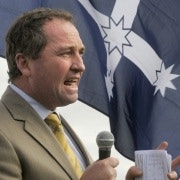Putting together the pieces of budget bluster
Is the budget 'out of control' or 'in tatters'? Are interest rates at 'emergency lows' because of the government's poor economic management? What's with all the spending cuts?
Let’s try to make a little sense of it.
First of all, the government is engaging in the pre-budget ritual of leaking the nasties, which creates a sense of 'horror budget looms' but which leaves the actual night itself free to pitch whatever goodies – and there may not be that many this year – undistracted by the bad things. So the Family Tax Benefit rise, and the second round of carbon price compensation in 2015, have both been quietly taken out the back and shot.
Climate Change Minister Greg Combet claimed today that the compensatory tax cuts for the 2015 shift to an emissions trading scheme would just be "deferred" until the point when the carbon price inflicted additional pain on consumers. But even if by some miracle Labor is still in government for the next decade, don’t hold your breath for those tax cuts.
This is perfectly sensible policy – if there’s going to be no inflationary impact because the carbon price is going to plummet the moment permits are tradeable with Europe, there’s no case for compensation. Ditto ditching Family Tax Benefits. We should be slashing Family Tax Benefits of both kinds so that only low-income earners receive them.
As part of its expectation management, the government has also confirmed there are big additional writedowns in tax revenue, mainly in corporate tax, capital gains tax and the Minerals Resource Rent Tax.
The MRRT is a uniquely Labor stuff-up, one personally autographed by Treasurer Wayne Swan and Prime Minister Julia Gillard, with a special thanks to former prime minister Kevin Rudd on the underside. But lower corporate tax revenue and capital gains tax revenue are beyond the control of the government. All it can do is decide whether to cut spending or lift taxes by the same amount in order to keep the budget in balance, which would undermine economic growth, or simply let the budget go into deficit. In practice, it’s doing both.
Julia Gillard successfully used the (unrelated) fact of revenue writedowns last week to sneak through a rise in personal income taxes that even garnered opposition support. The revenue is ostensibly hypothecated to the NDIS, but it simply means there is less pressure for savings or tax rises elsewhere in the budget.
But problematically, the government still needs to find 'structural savings' to fund the rest of the National Disability Insurance Scheme (now called DisabilityCare) and the Gonski education funding reforms, which, at least in NSW, kick off next calendar year with additional funding (the full Gonski will cost around $760 million next financial year and then $1.5 billion a year thereafter). It has already made some savings on superannuation, though not enough.
So, the key budget risk is that we’ve already seen all the nasties: what we need is more spending or tax expenditure cuts in the budget, but long-term ones, that have minimal impact now but a big impact at the end of the forward estimates and beyond.
To this end, of course, other budget rituals are being performed. As he’s done for most budgets over the last decade, Access Economics' Chris Richardson has come forward to demand savage spending cuts. In centuries to come, one expects that Richardson, like Hari Seldon in the Foundation novels, will continue to regularly appear as a hologram long after his death, flickering to life every May to demand big cuts in government spending no matter what. There are now many imitators of Richardson – The Australian Financial Review has adopted Stephen Anthony of Macroeconomics as its own – but for mine there's nothing like the original, no matter how badly wrong he gets his predictions, or how many times he called the mining boom over.
The Reserve Bank, meanwhile, has the onerous task of trying to pump up the non-mining economy by itself, as governments across the country curb spending and our currency refuses to fall. Yesterday's rate cut led to some peculiar rhetoric from shadow treasurer Joe Hockey, who long insisted that Labor’s poor economic management and fiscal indiscipline meant interest rates would be higher, but who now says Labor’s poor economic management is why interest rates are lower.
But the days of "interest rates will always be lower under a Coalition government" seem long gone. In the post-financial crisis world, in which our economy is a safe haven and our currency is Aussiesaurus Rex, we may need to revise our understanding of what 'high' and 'low' interest rates are.
The result is a pre-election economic debate that is entirely opposite of the one we were having last time we changed government. In 2007, the Howard government was throwing mining boom money at anyone not fast enough to get out of the way, inflation was starting to spike and the Reserve Bank was trying to slam the brakes on, even controversially lifting rates during an election campaign in which both sides promised big handouts until Kevin Rudd cleverly saw advantage in piously declaring an end to the spendathon.
This time around, we're nearing deflation in spite of the government introducing a carbon price, the government will go into an election taking back handouts, its opponents will thunder about the need to slash spending, and the Reserve Bank, desperate to pump some life into the economy, might even cut rates again.













